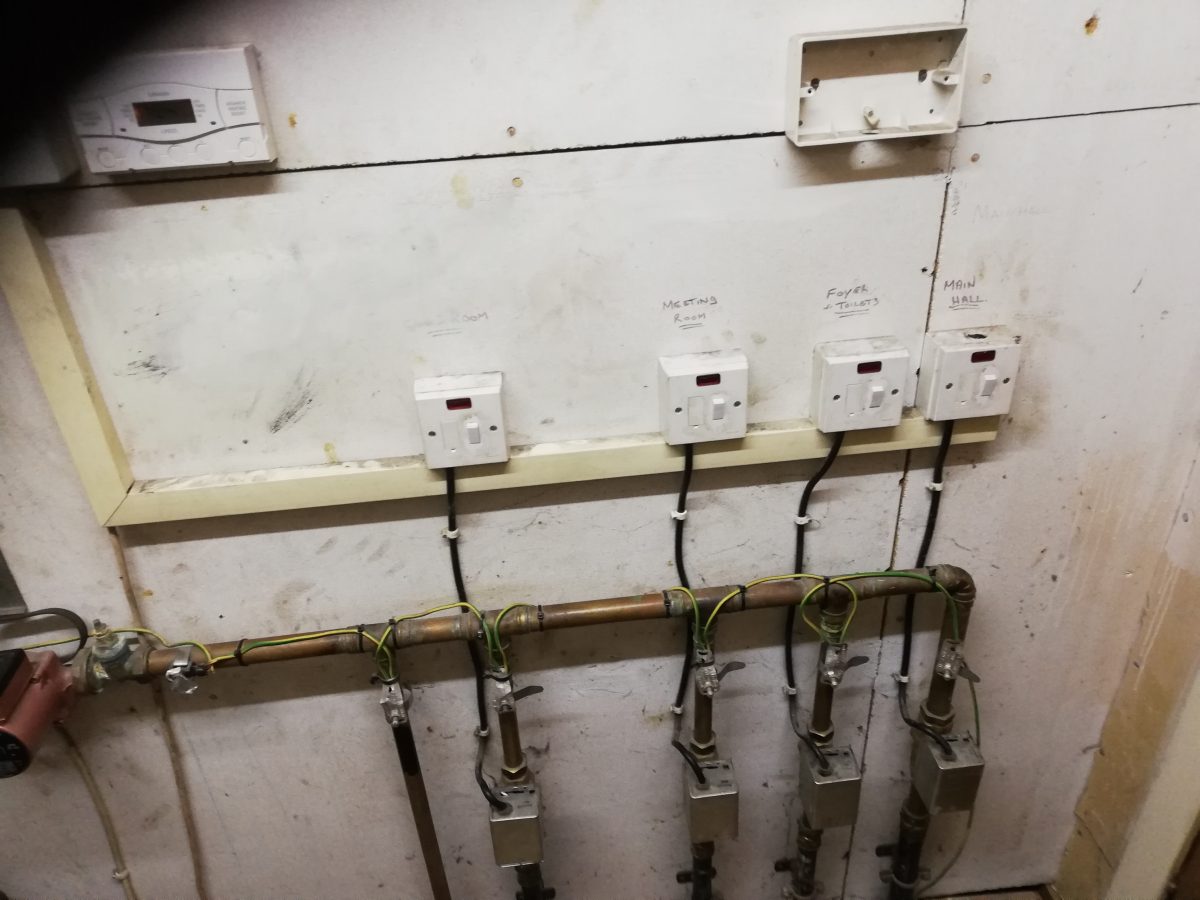We think this is an interesting example of losing track of the original heating system design over the years.
This venue has two large halls and a hot water tank, heated by a single boiler. The boiler serves four heating zones: one for the large hall, one for the small hall, one for a meeting room connected to one of the halls, and one for the toilets. The heating to each zone can be controlled using a Honeywell motorised valve. Each motorised valve is connected to an on-off switch.
Currently the venue has one domestic two-channel timeswitch, and it’s not clear how it’s wired. In a residence, usually one channel would control the heating and the other the hot water tank – this was before combi-boilers were common – but they aren’t getting hot water ever. From what we’ve been told they have to go in between every building use to set the heating and control where the heat goes, but we’ve heard a couple of versions of exactly how that’s meant to be done. They do think it’s only possible to heat the small hall if the big hall is also being heated, which is not an ideal position to be in.
Our energy adviser, Andrew MacOwan, has spent most of his career in churches and halls and he thinks he knows what’s happened. When the system was designed, it probably had two two-channel domestic timeswitches – there’s even what looks like the empty back of one on the wall. This was fairly common practice in church halls because they’re cheap. Instead of controlling heating and hot water, each channel would control a different heating zone. The electrician then either put the hot water on a third timeswitch or arrange for it to come on whenever any of the zones is heated. What looks like on-off switches for the motorised valves are really just “fused spurs” for the convenience of the electrician when they need to work on anything. They are meant to be left on otherwise.
Their current arrangement makes being a heating volunteer a big job. We know a few venues that want new heating controls as much to save volunteer effort as to save energy. Luckily, Andrew knows these Honeywell valves well and they are still in common use. They’re likely to either still work or be repairable, and if not, they should be relatively cheap to replace, perhaps as little as £100 each. Two-channel domestic timeswitches are also cheap, and there are even cheap four-channel timeswitches available. However, we aren’t recommending the group get them without thinking a little first – because going for something a bit more modern would save energy and pay back relatively quickly and would make the heating volunteer’s job easier still.
The cheapest timeswitches still just bring the heating on when you say – if you program it for 9:00, the heating starts at 9:00. Better ones have “optimised start control”. You tell it what temperature you want it to be when, and they learn from experience when to turn the heating on. That’s maybe not so important in a place that’s heated all the time, but otherwise, it makes sure the right amount of energy is used to make the space comfortable exactly when it’s needed. This does take putting a temperature sensor in each zone, but they don’t often need to be wired, which is the expensive part. Some models also require an external temperature sensor, but others learn based on how fast the temperature is changing on the indoor sensor.
With a temperature sensor in each zone, any thermostatic radiator valves in the same space as the sensor should come out – but that does leave an issue about what the users do if they’re too hot or too cold. They will always do something, and you want it to be the right thing – something that changes what the heating system is doing but only while they’re in the space. Getting that right is going to take choosing carefully and talking to whoever is going to wire it in, because they may have good ideas.
In this particular case, if there’s one location for the heating controls to go – a front entrance that splits into the two halls, for instance – I think something like a Warmworld Dataterm might work for them.
With the “partial” lock on, this lets users put the heating up or down for a short time using two buttons – ideal for stopping any “thermostat wars”. However, this is just an example. We can’t endorse any particular product. There will be other ways to get the same effect and some of them would allow the heating to be set from home. The group needs to work out what they need and I’ll try to help them figure out what will do it, keeping in mind that not all controls work with all boilers.
This particular group also needs to think about payback periods, because their boiler is ancient – 35 years service for a boiler designed to last 20-25 years. It could fall over any day. Their building is an ideal candidate for a refurbishment grant because it is relatively easy to insulate, probably small enough for a heat pump, and appears to be in an area without many community spaces. If they aren’t going to go for a big retrofit and stay in occasional use, then they may want to go with infrared panels or some other form of heating that is only on while people are in. The less time they’ll be running on gas, the harder it is for new controls to pay for themselves. The pipework is beefy enough that work on the motorised valves might still be useful if a heat pump goes in, but the heating controls would not. That makes knowing the future plan just as important as knowing how the building is used now.
